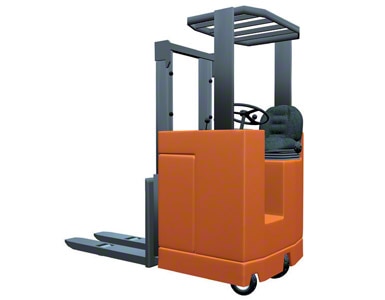A pallet stacker is essentially a pallet truck equipped with lifting elements. The lower skids are inserted below the pallets, which explains why the lower pallet boards must always go in the direction of penetration and never crosswise. Otherwise, they would break on lifting and inserting them in, for example, drive-in racks.
Stackers are electric. In the market, there are both foot-operated models and rider models, which are ridden by the operator seated or standing on a platform.
 |
 |
|
| Pallet stacker not ridden by operator. | Rider stacker. |
Comments about stackers
Like forklifts, stackers are versatile. However, it is important to be very clear about their limitations.
Stackers are only the best option when the number of movements is very limited. It should be remembered that the lifting height of these handling elements does not exceed 3 m for the pedestrian type, and 6 m for the ridden one.
Certain stacker types include side stabilisers that open when the forks are raised above a set height.
Another important issue is that the lower legs go under the pallets and the forks fit into these lower skids. Some stackers have these open and the pallets stay inside, but during their use with racking units this tends to cause problems even if the first location level has been raised, since the skids can coincide with the uprights of the racks, making it impossible to approach the space.
In addition to these factors, it should be remembered that with stackers, the mast (the vertical part along which the forks move up and down) is rigid. Therefore, contingencies must be made for adjustments to certain racking units, such as those with gravity flow (which must have split rollers), so that they are compatible with the operations of these machines.

